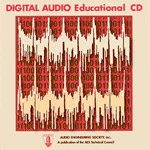 |
||
June 9, 2010 - Conferences in Sweden and Denmark Start Next Week, Digital Audio CD Released, New Tutorial and JournalTable of Contents
AES 38th Conference on Sound Quality EvaluationAES 38th International Conference, 2010 The conference focuses on the perceptual evaluation of sound quality. This is a complex field that involves a number of diverse disciplines including engineering, psychology, statistics, aesthetics, and language. Classical psychoacoustics has tended to concentrate on studying relatively simple stimuli and their auditory response, whereas sound quality evaluation requires methods that connect more directly with everyday listening experience, perhaps using real-world program material and contexts. Increasingly, attempts are being made to emulate the human perception of sound quality using computational models. As part of the conference two workshops sessions are being organized to allow for demonstration and interaction with presenters. These sessions aim to bring an air of informality to the event and allow presenters to share the latest methods and approaches for open discussion. To learn more about these sessions please click here. Advance registration will be open until 10 June 1800 GMT so check the website for details and make your travel arrangements before it's too late!
AES 39th Conference on Audio ForensicsAES 39th International Conference, 2010 If you have any interest in current practices or future directions in audio forensics...if you are considering audio forensics as a career....or if you want to enhance your career development: the AES 39th International Conference in Denmark is definitely the event to attend. The technical program is very exciting, covering speech, authentication, gunshot analysis, laboratory reviews, etc., as well as tutorials and workshops. Furthermore, the program and participants are truly international, with presentations from 11 different countries. The papers (21 in total) have been selected by Alan Cooper of the Metropolitan Police UK, and Durand Begault, Audio Forensic Center, SF, US. The paper presentations are relevant to both researchers and to audio forensic professionals, and are grouped in the sessions: "Authentication", "Speech and Forensics - Voice Identification", "Speech and Forensics - Automated Systems", "Enhancement of Noisy Recordings", "Acoustical Forensics", "Laboratory Procedures", and "Speech Quality and Intelligibility Assessment". Two important tutorials that address cutting-edge techniques in the field are presented by Geoffrey Stewart Morrison of Australian National University and members of the SWGDE (Scientific Workgroup on Digital Evidence) based in the US. Workshops on practical issues are organized by Gordon Reid of Cedar Audio UK, and Catalin Grigoras of Forensic Science Center, Romania. In addition, companies specializing in audio forensic hardware and software, as well as educational institutions, are exhibiting. It all takes place at an intimate, comfortable venue in beautiful surroundings (just a short distance from the magical city of Copenhagen) that provides the perfect facilities for a highly productive and unforgettable conference.
Digital Audio Educational CD ReleasedThis new educational CD, produced by the AES Technical Committee on Signal Processing (TC_SP), is intended primarily to address issues relevant to digital signal processing algorithm designers and implementers. Digital audio systems have obviously become ubiquitous in recent years, due in large part to the ingenuity and effort of Audio Engineering Society members. The maturity of the digital audio signal processing field can present a serious challenge for new students, researchers, software engineers, product testers, and other newcomers who must try to understand the relevance and relative importance of various signal processing parameters without being able to hear and see the details and effects: simply reading a written description is not the best way to learn and understand audio processing issues. Since a typical characteristic of audio digital signal processing algorithms is the need for sustained, uninterrupted processing, even a single sample dropout or parameter update error can result in an audible artifact. Detecting, diagnosing, and correcting this sort of implementation error often requires experience listening for the defects, and examples of this type are included on this CD. The examples on this disc are intended to demonstrate a variety of the effects, both good and bad, that digital audio signal processing engineers are likely to come across in their work.
Tutorial on Binaural Audio TechnologyThe latest in our series of online tutorials is now available at http://www.aes.org/tutorials/ Binaural Audio Technology—History, Current Practice, and
Emerging Trends These tutorials are only available for viewing online and are not currently available to download for offline viewing. The AES is grateful to Michael Williams for his work in post-producing these tutorials so that they can be made available to its members. You can view a trailer of this presentation on YouTube. Francis Rumsey, Online Tutorials Project Manager
Job Board UpdateThe AES Job Board is where our sustaining members post their latest job openings. As an AES member you have exclusive access to this list. The most recent postings can be found here:
AES Journal May Issue Now AvailableThis issue includes:
|
||
|
|
||





